Why Arabidopsis Why: High Yielding Maize Variety
This post is written by me as part of Why Arabidopsis Why and edited by Dr. Ian H. Street. First published in The Quiet Branches. Please follow the link below or read here.
Like
us, plants have stem cells too. These are innate, undifferentiated cells
localized in both root and shoot meristems. They house precursor cells that
divide, elongate/expand, and finally form differentiated tissues and organs of
plants. It’s how plants generate the roots, trunks, branches, leaves, flowers,
and all the other structures we witness as the green world.
The
shoot apical meristem (SAM) is a complex structure consisting of three distinct
layers (denoted L1, L2 and L3) in the dicot (one of the two major groups of
flowering plants) Arabidopsis thaliana.
L1, L2 and L3 form the epidermis, sub-epidermal tissues, and inner tissues of
the shoot, respectively [1]. Cells in the L1
and L2 layer divide in a sideways fashion, keeping these layers distinct,
whereas the L3 layer divides in a more random fashion.
Apart
from the cell layers, the SAM is divided into three dynamic functional zones/cell
populations. The central zone (CZ) is maintained through a low rate of cell
division and supplies cells for the peripheral zone (PZ) and the rib system
(see the figure below). The (PZ) is responsible for the formation of lateral
organ primordial like leaves (P), whereas the rib meristem (RM) pushes the SAM
upward. A group of cells residing directly below the stem cells in the CZ is
referred to as the organizing center (OC) [2].
Shoot
meristems are maintained by pluripotent (unspecialized with potential to become
any cell type) stem cells controlled by CLAVATA-WUSCHEL feedback signaling.
This pathway, which coordinates stem cell proliferation with differentiation,
was first identified in Arabidopsis,
but appears to be conserved in diverse higher plant species including crops. The
CLAVATA3 (CLV3) - WUSCHEL (WUS) signaling pathway has evolved as the central
regulatory pathway that coordinates stem cell proliferation and
differentiation. This coordination is achieved via an auto-regulatory
negative-feedback loop comprising the stem cell-promoting transcription factor
WUS and the differentiation-promoting peptide CLV3. CLV3 – WUS maintain a
circuit, where CLV3 is only expressed in stem cells of SAM and perceived by
receptor like proteins in OC and repress WUS expression. Due to the repression
of WUS, few stem cells are maintained and reduction in CLV3 production [3].
To
understand the function of a gene, scientists usually mutate that particular
gene leading to loss-of-function (LOF – i.e. “breaking a gene”) or
gain-of-function (GOF – i.e. “making more of a gene or making it more effective
than usual”) phenotype of plants. Based on our knowledge about CLV3 – WUS
circuit combined with mutant studies, take a look at SAM development of a crop
plant, maize (Zea mays).
Through
mutagenesis screening, fasciated ear 3
(fea3) mutant has been identified
which contains a larger SAM like clv
mutant. FEA3 is a CLV-type LRR (Leucine Rich Repeat) receptor-like gene
localized to the plasma membrane. So, it was predicted that exogenous application
of CLV3 would reduce SAM size. They applied CLV3 peptide to two mutants (fea2, fea3) and found that fea2
is resistant for meristem growth, but not fea3.
It tells us that FEA2 perceives CLV3, not FEA3 [4].
The
next idea was that FEA3 perceives something other than CLV3. According to
phylogenetic analysis, three similar genes (ZmCLE7,
ZmCLE14 and ZmFCP1) to CLV3 were
identified in Zea mays. When these
three peptides are applied exogenously on wild type plants, they reduced root
growth. But, when these three peptides are applied exogenously on fea3, ZmFCP1showed resistant for root
growth and SAM size also. Additionally, Zmfcp1
mutants also show fasciated ear phenotype and suggests that FEA3 – FCP1 pathway
is regulating SAM signaling from differentiating cells [4].
Although
CLV – WUS system is conserved from model plant Arabidopsis to crop plants, buffering of this circuit is more prominent
in Arabidopsis than in crop plants. Even weak mutants of this circuit show
significant phenotypes, because crop plants went through selection based on
yield during domestication. Over the years, farmers selected the varieties
containing increased kernel row number, kernel numbers per ear, and ear weights
without considering the underlying mechanism. Comprehensive molecular biology
and phenotypic study of fea3 mutant
showed that high yielding variety is actually a reflection of a manipulated CLV
– WUS circuit [4].
This
study from Je et al. [4] has shown the promising
impact of basic research to translate into an applied field such as developing
high yielding crops. At the same time it suggests a universal pathway to
control cell differentiation during plant development.
References







Comments
Post a Comment